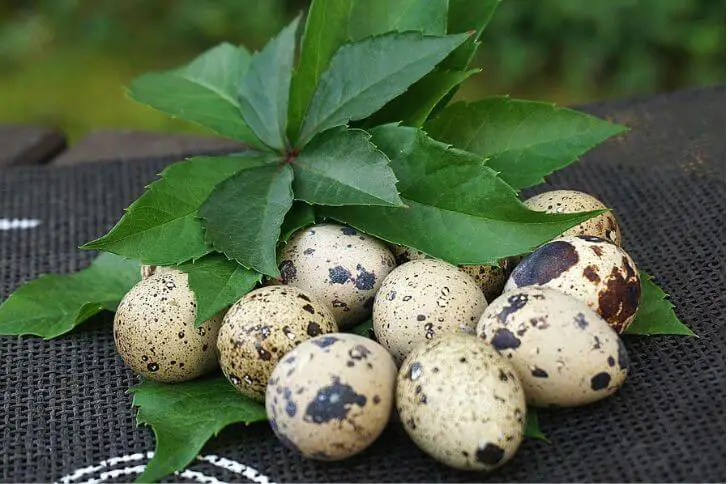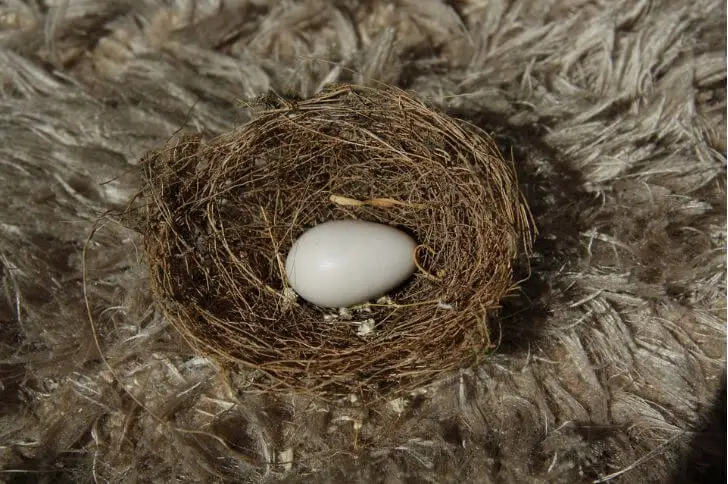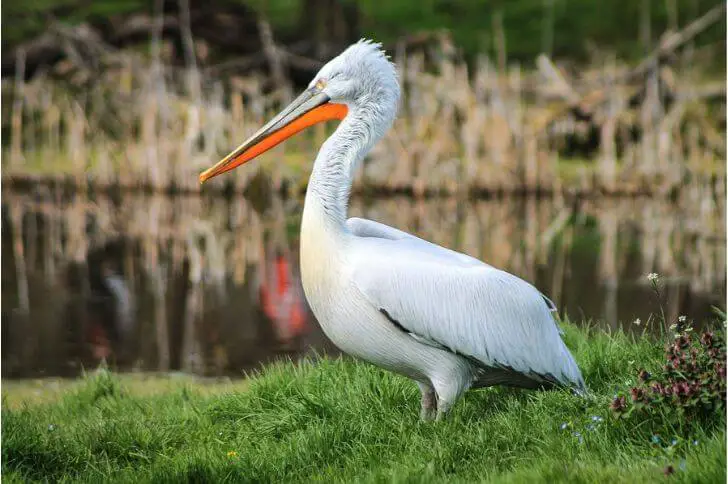In North America, the red-headed woodpecker is one of the easiest woodpeckers to identify. The adult has a round-red head, black back and white underparts. Both sexes sport white patches on their black wings which give an illusion of a white lower body.
This bird is about 7-9.5 inches in length with a wingspan of 16-18 inches. But enough about the red-headed woodpecker adult. What about juveniles? Do they share plumage and other distinctive habits with adults? Keep reading to learn more.
What months do red-headed woodpeckers lay eggs?
In North America, red-headed woodpeckers typically lay their eggs between April and July. The female will usually lay between three and seven eggs at a time, and like other woodpeckers eggs they are about 1-inch and all white. After about two weeks, the eggs will hatch, signifying the beginning of the next step in the red-headed woodpecker’s life.
A glimpse at a baby woodpecker’s first days
Ever seen a red-headed woodpecker’s baby? If not, their new chicks are born naked and blind, kind of like blackbird babies. At this point, they are helpless and the deep cavity nests help protect them from predators.
What do juvenile red-headed woodpeckers look like?
When the young bird sheds down feathers, new juvenile feathers grow in their place. Also, juvenile plumage is different from the adult’s coloring.
A juvenile red-headed woodpecker has a brown head, brownish-black back, and pale underbelly. The first few weeks of its juvenile stage, a fledgling has reddish cheeks, that’s where the red coloring on its head starts. Gradually, the red will spread to the rest of its head.
Another distinctive feature to note is the white patch on the wing; well both wings. In time, the patches become more prominent as the bird ages.
Related Read: Downy woodpecker juvenile
Fledlging size
Most red-headed woodpecker juveniles are about the same size as their parents. However, there can be some variation in size, with some young birds being slightly smaller. The average length of a red-headed woodpecker chick is about 5-7 inches . The wingspan is usually about 13-15 inches.
Eating habits
These North America Bird species are interesting creatures and the juvenile red-headed woodpecker is no exception. These birds are known to eat a variety of different foods including insects, fruits, and nuts. While the exact diet of these woodpeckers can vary depending on the location, they typically eat whatever is most abundant in their environment.
Insects make up 25% of the juvenile red-headed woodpecker’s diet. These birds will oftentimes feed on ants, beetles, and caterpillars. The remaining 75% consists of seeds and fruits and at times other birds eggs.
Also, did you know that the feeding role is equally shared by the parents? The pair will regurgitate food to their young. This happens every one hour or so.
How long does it take a red-headed woodpecker fledgling to fly?
A red-headed woodpecker fledgling typically takes around 6-8 weeks to fly. This may vary depending on the weather and the size of the bird, but generally, they will be able to fly by 2 months old. The parents will help teach the young bird how to fly, and once they are proficient, they will be able to leave the nest and start their own life.
Molting process
A red-headed woodpecker’s or the Melanerpes erythrocephalus head is not always red. The juvenile woodpecker molts into its adult plumage by the end of its first summer. This usually happens between late July and mid-August.
As it molts into its adult plumage, the young woodpecker’s head becomes more and more red until it resembles that of the adult. The white patches on wings become more prominent, its back becomes black and the bill grows longer and sharper.
How long before baby red-headed woodpeckers leave the nest?
Baby red-headed woodpeckers leave the nest anywhere from 27 to 31 days after they hatch. The parents will continue to feed them until they are able to fend for themselves. Once they leave the nest, they are on their own and must find food and shelter. Although they are independent, they will still stay close to their parents for protection.
How long does it take a woodpecker to mature?
The average lifespan of a red-headed woodpecker is about 9-12 years. However, it takes these birds about 2 years to reach maturity. This means that the bird spends its first 2 years of life growing and maturing into an adult. Once the bird reaches adulthood, it will spend the rest of its life breeding and raising young.
What do you feed a baby woodpecker?
When it comes to feeding a baby red headed woodpecker, there are a few things you need to keep in mind. First, you need to make sure that the food is small enough for the bird to eat. Second, you need to make sure that the food is soft enough for the bird to digest. And third, you need to make sure that the food is high in protein.
One of the best foods to feed a baby red headed woodpecker is insects. Insects are small and easy for the bird to eat. They are also soft enough for the bird to digest. And they are high in protein, which is important for the growth and development of the bird.
Another good option for feeding a baby red headed woodpecker is seeds and berries.
Where do red-headed woodpeckers sleep at night?
Researchers found that these unique black and white birds roost in trees, often near the trunk, and typically in cavities or other areas with some cover.
These woodpeckers are flexible in their sleeping arrangements, and they may use different roosting sites depending on the availability of food and other resources.
Do red-headed woodpeckers return to the same nest?
A new study has found that red-headed woodpeckers are more likely to return to their natal nest like other woodpecker species. T
Natal philopatry is an important behavior because it can help them weather environmental changes and connect different populations.
What do you do if you find a young woodpecker?
If you find a juvenile red-headed woodpecker, the best thing to do is to leave it alone. These birds are very independent and will usually leave the nest on their own within a few days. If the bird appears to be injured or in distress, you can contact a local wildlife rehabilitator for help.
How do you care for a fledgling woodpecker?
Fledglings are young birds that have grown their feathers and are able to fly for short distances. While they are learning to fly and hunt, they are still dependent on their parents for food and shelter.
If you find a fledgling red-headed woodpecker, there are a few things you can do to help care for it.
First, make sure the area around the bird is safe. Keep pets away from the area and remove any potential hazards.
Next, you will need to provide food and water for the fledgling. The best way to do this is to put out a shallow dish of water and place some insects or seeds.
Finally, keep an eye on the bird and make sure it is not in danger of being attacked by predators or other animals.
Sources:
https://en.wikipedia.org/wiki/Red-headed_woodpecker
Hi, my name is Steve. My friend and I started the spanishbirdguides.com to share our passion with other like-minded people. So, if bird watching is your thing, you’ll love this blog. I’ll share what I’ve learnt about both local birds and those found in other parts of the world. Also, I’d love to hear your experiences.



